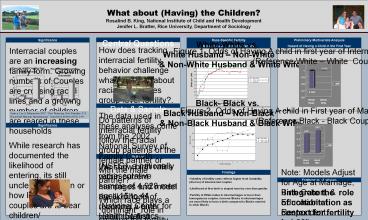60x36 Poster Template - PowerPoint PPT Presentation
1 / 1
Title:
60x36 Poster Template
Description:
Previous research shows that within-couple differences (gender and race) matter ... plays a 'dominant' role in shaping the fertility behavior of the couple? ... – PowerPoint PPT presentation
Number of Views:101
Avg rating:3.0/5.0
Title: 60x36 Poster Template
1
What about (Having) the Children? Rosalind B.
King, National Institute of Child and Health
Development Jenifer L. Bratter, Rice University,
Department of Sociology
OPTIONALLOGO HERE
OPTIONALLOGO HERE
Significance
Race-Specific Fertility Same-Race vs.
Interracial Fertility
Preliminary Multivariate Analysis Hazard of
Having a Child in the First Year
Central Questions
How does tracking interracial fertility behavior
challenge what we know about racial differences
group-level fertility?. Do patterns of
interracial fertility follow the racial group
patterns of the female partner or with the male
partner? Which race plays a dominant role in
shaping the fertility behavior of the couple?
Interracial couples are an increasing family
form. Growing numbers of Couples are crossing
racial lines and a growing number of children are
reared in these households .
White-White vs. White Husband Non-White Wife
Non-White Husband White Wife
Figure 1. Odds of Having A child in first year of
Intermarriage by race of spouse (Reference White
White Couples)
Data Sample
Black- Black vs. Black Husband Non-Black Wife
Non-Black Husband Black Wife
The data used in these analyses come from the
2002 National Survey of Family Growth (NSFG), a
nationally representative sample of 4,928 men
ages 15 to 44 (National Center for Health
Statistics 2004). For this preliminary
analysis, we draw a sample of males who report
having current wives or partners and who provide
valid information on their wives race and
Hispanic ethnicity (n1,672) and focus
specifically on those reporting marriages
(n1,045).
Source Lee Edmonston 2005. New Marriage, New
Families U.S. Racial and Hispanic Intermarriage
Population Bulletin 60(2)1-40
Figure 2. Odds of Having A child in First year of
Marriage by race of spouse (Reference Black -
Black Couples)
Significance
While research has documented the likelihood of
entering, its still unclear how often or how
likely such couples are to bear
children/ Race-Specific Trends in Fertility
provide some hints Some racial trends in
fertility are moving in the same direction (e.g.,
White and African American) some are moving
differently (e.g., Non-Hispanic White and
Hispanic Previous research shows that
within-couple differences (gender and race)
matter for generating differences between couples
(race-specific differences)
Methods
We show birth rates within current marriages and
model the likelihood of reporting a birth within
the first marriage We employ event history
analysis predicting the hazard of a birth within
the first year of marriage, using complementary
log-log model for continuous time processes using
PROC GENMOD in SAS (Allison 1995). We adjusted
for the effects of the complex sampling design
using weighted generalized estimation equations
(GEE)
Note Models Adjust for Age at Marriage, Birth
Cohort, Education of Respondent. plt.001
Findings
Forthcoming Analyses
- Integrate the role of cohabitation as context
for fertility behavior - Include more groups
- Add controls for other indicators of achieved and
ascribed traits that impact both whether or not a
child is born and whether or not a couple is
intermarried































